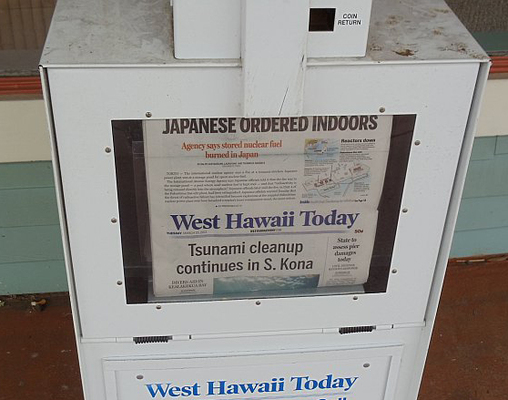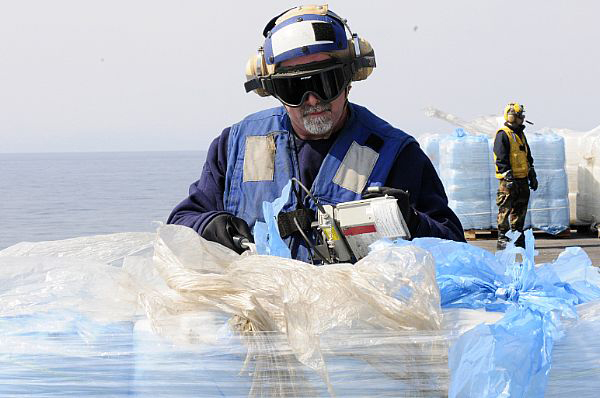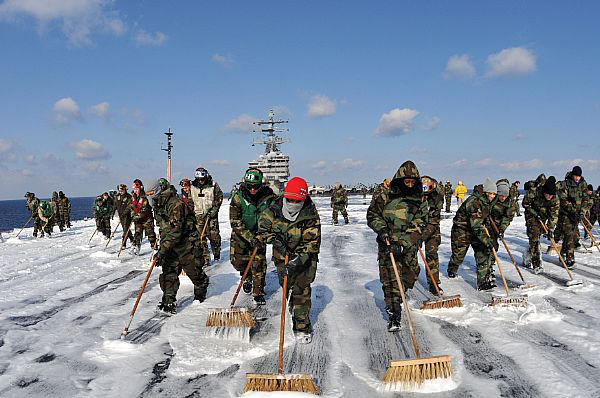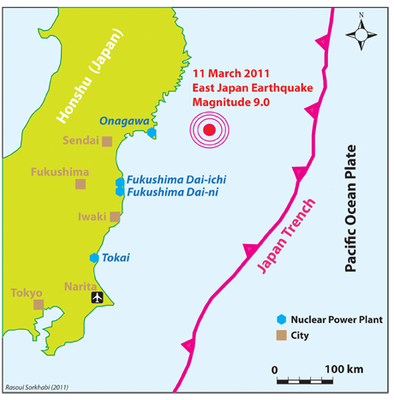
by Rasoul Sorkhabi Friday, January 20, 2012

Newspaper from Hawaii a couple of days after the earthquake and tsunami, when concern over radiation from the crippled Fukushima Daiichi plant was just beginning to take hold. Megan Sever

Radiological physical science technician Mark O'Conner scans humanitarian assistance supplies for radiation aboard the USS Essex, off the coast of Japan. U.S. Navy photo by Mass Communication Specialist 1st Class Johnie Hickmon

Sailors aboard the aircraft carrier USS Ronald Reagan wash down the flight deck to remove potential radiation contamination from the Fukushima Daiichi nuclear power plant. U.S. Navy photo by Mass Communication Specialist Seaman Nicholas A. Groesch

Map showing the location of the March 2011 earthquake and major cities and nuclear power plants on northeast Honshu, Japan. Illustration by Rasoul Sorkhabi
Before it happened, it was hard to imagine that a combined megaquake and tsunami in Japan could cascade to a nuclear disaster. Yet that’s exactly what happened at the Fukushima Daiichi (Number 1) nuclear power plant, 220 kilometers northeast of Tokyo, last month. This incident has put Japan’s nuclear policy in the spotlight, but its implications go far beyond a single country. After all, Japan possesses only 55 of the 442 nuclear plants operating around the world.
Japan, the world’s third-largest economy and home to 127 million people, has an acute shortage of natural resources. It imports 80 percent of its primary energy. Thirty percent of its electricity comes from nuclear power. Japan needs a steady flow of enormous energy to maintain its technological power, economic base and high standards of living. In a way, Japan epitomizes the critical energy situation that the overpopulated and economically ambitious world is going to face in the near future. Therefore, discussions on the inventories, economics, pros and cons of all energy resources and technologies are urgently necessary.
Every energy technology has its own potential hazards: Mines may collapse and kill miners; mining releases hazardous elements into the environment; offshore oil rigs can catch fire; oil spills poison marine life; oil refineries and gas pipelines may explode (indeed, the tsunami caused the explosion of a large oil refinery); hydropower dams may fail and cause floods; wind turbines may kill birds and deafen other animals. But a meltdown at a nuclear reactor and the huge release of radiation into the air, water, soil and food chain far exceeds the hazards from many other energy technologies, in terms of both its expanse and duration. Although as I write this in early April, the news about Fukushima is still unfolding (see "What happened at Fukushima?" for more details), whatever direction it takes (and let’s hope for the best), this nuclear accident has already demonstrated nuclear power is still not disaster-proof.
Japan started investing in nuclear energy in 1954 in the very early years of the atomic age. Those were the days of nuclear optimism — the promise of an almost infinite, free source of energy for humanity. Alas, that dream did not come true.
In recent years, nuclear energy has been attractive for some governments because it is viewed as a significant way to reduce our atmospheric emissions of carbon dioxide from the burning of fossil fuels. For example, Japan, which hosted the 1997 Kyoto Protocol meeting, has plans to increase its nuclear power generation. Indeed, the Tokyo Electric Power Company, which operates the Fukushima plant, announced in 2008 its plans to add two new reactors to that power plant. Of course, this year’s disaster has likely changed all that. The problems at Fukushima highlight several important points that will undoubtedly shape discussions on nuclear power for years to come.
First, can we produce nuclear energy without running the risk of irradiating people? In theory, it may be possible: A large number of nuclear reactors have been operating for decades and as far as we know, nuclear accidents have seldom occurred. Nonetheless, such accidents have happened and can happen again. Indeed, given the reputation that Japan has for its management style, attention to details and advanced technology, the Fukushima accident suggests we cannot mitigate the risk entirely whether on the technological or management level. The current situation thus highlights the danger of nuclear accidents in other — and especially in less prepared — parts of the world now and in the future. This in turn highlights the critical role of international supervision in the nuclear sector globally, and enforcement of higher nuclear safety regulations on the national level.
Secondly, unlike the previous nuclear accidents in Japan and elsewhere, which were due to human errors or technical failures, the Fukushima disaster was caused by a natural hazard. Such a situation begs the question: Can we build plants that are fully safe from natural hazards? Ideally, nuclear facilities should be in areas not prone to natural hazards. But here we face a paradoxical situation: Nuclear power plants are there to generate electricity, which means they cannot be too far from centers of populations and industrial activity, and these are largely located in world regions prone to natural hazards of one sort or another.
Earthquakes, volcanic eruptions and tsunamis are relatively common around the whole Ring of Fire in the Pacific and Southeast Asia from Indonesia, Taiwan and Japan to Alaska, California and Chile. Earthquake-prone California is already home to four operating nuclear reactors. The majority of U.S. reactors, in the East and South, are also within reach of natural hazards such as hurricanes. In continental Eurasia, most people live along the seismically active Alpine-Himalayan tectonic belt, spanning from Spain to Switzerland to Turkey to Iran, Pakistan and northern India, where destructive earthquakes are common. Therefore, nuclear facilities in these regions cannot be absolutely safe from natural hazards. But we can make sure they are placed in relatively less-hazardous locations, and that utmost care is taken to construct disaster-resistant facilities and to upgrade contingency plans in case of accidents.
We also try to mitigate risks, by, for example, having plants shut down when an earthquake strikes, as Japan’s automated system does. But again, Fukushima shows that the system isn’t perfect: The nuclear disaster occurred after the facility had already been shut down. On the day of the earthquake, three of the plant’s six units were not operating (shut down for routine maintenance) and the other three units were shut down by an automated system that sensed strong ground shaking. The Fukushima disaster has awakened the public to the fact that nuclear plants, even if not operating, require 24/7 maintenance because the radioactive fuels rods (even the spent rods) still release huge amount of heat and should thus be kept cool and safe.
When that doesn’t happen, as is the case at Fukushima, disaster can ensue. This disaster has yet again also revived the decades-old and yet unresolved problem of nuclear waste disposal. Currently, in the absence of safe underground storage, thousands of tons of spent fuel rods are sitting on the ground at hundreds of nuclear plants around the world and are kept cool by water; how safe are they from natural hazards? Or for that matter, how safe are they from people who may be up to no good? These are important questions that the public needs to ask and officials must clarify.
Then there is the issue of materials: When oil prices increase abruptly, we think of tapping non-petroleum resources such as nuclear power. We think of switching to nuclear power to decrease our dependency on imported oil from relatively unstable parts of the world. But like the petroleum industry, nuclear power utilizes minerals (uranium and plutonium) that are finite and expendable, and are concentrated in certain areas, notably Canada, Russia, Australia and parts of central Asia and Africa. Japan and the U.S. both import the bulk of their uranium from overseas. So if more countries go nuclear, the price of uranium will rise because of increased demand.
Of course, thanks to Fukushima, this year seems to be different: Even at a time when violence and revolts in the oil-rich Middle East and North Africa have pushed oil prices well over $100 a barrel, it is particularly difficult to advocate expansion of nuclear power. This should provide some momentum for the development of natural gas and renewable (solar, wind and geothermal) energy sources.
As I was watched the surreal, horrible images of the tsunami floods destroying the coastal towns in Japan last month, I wondered how much we have overlooked the use of tidal power to generate electricity. Tides occur continuously and in a predictable manner. And coastal areas of the world are also often populous and thus in need of electricity. I also couldn’t help but wonder about natural nuclear power: the nuclear fusion that produces sunlight and heat. Of course, solar power that reaches Earth is far less concentrated than many other energy sources, but its total amount is significant and we currently harness very little of it. Moreover, we do not have to drill deepwater basins to extract it or pile up hazardous radioactive materials to produce it. And rooftops, which can easily be covered with solar panels, remain the most wasted (and aesthetically the least charming) part of our buildings. But of course, no renewable option is without its challenges as well.
Nuclear energy like any other energy source is charged with policy debates. Proponents of each energy resource often ignore or downplay the negative aspects of their favored one while highlighting those of other energy resources. So perhaps one should not be overly negative about nuclear power. After all, it has the highest energy to mass ratio of all energy resources available to us. People who have been working in the nuclear plants have done their best to safeguard them while producing energy for society. Radionuclides and research reactors have already played a vital role in modern medicine. And perhaps, technological advancements will find relatively less risky ways to handle nuclear wastes and ensure the safety of nuclear power plants.
It is important to keep an open mind to these notions and the possibilities of nuclear power production in certain places. Nevertheless, none of these arguments should make us blind to the costs and risks inherent in today’s nuclear power plants around the world, as Fukushima so painfully has demonstrated.
It is too soon to assess the fallout of the Fukushima disaster for nuclear policies around the world. But in the aftermath of this disaster, some countries like the U.S., Germany and China have begun to re-evaluate the safety standards of their nuclear plants.
One important lesson Fukushima has taught us is this: The safety of nuclear plants is too vital to be entirely left to utility companies; international inspections, strong national regulatory standards and public watchdogs are all necessary to ensure their safety.
And globally, if indeed nations decide to move away from nuclear power toward new energy technologies and renewable sources, this will also help international security and reduce nuclear competition and chances of nuclear terrorism; a world with less stockpiled radioactive materials is also safer.
© 2008-2021. All rights reserved. Any copying, redistribution or retransmission of any of the contents of this service without the expressed written permission of the American Geosciences Institute is expressly prohibited. Click here for all copyright requests.